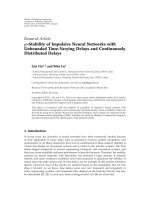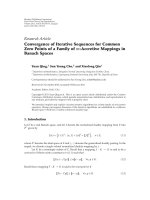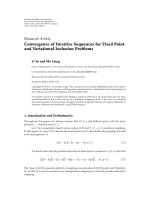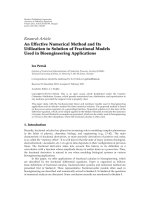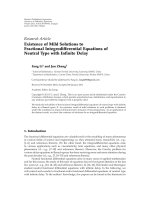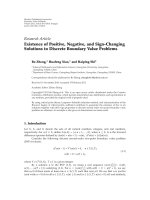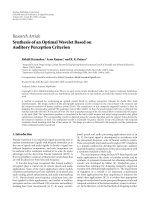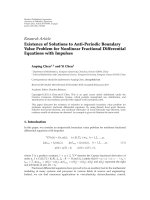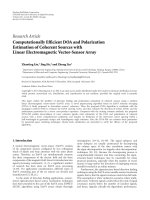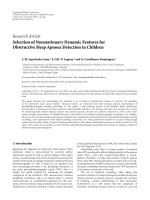báo cáo hóa học:" Research Article Derivatives of Orthonormal Polynomials and ´ Coefficients of Hermite-Fejer Interpolation " docx
Bạn đang xem bản rút gọn của tài liệu. Xem và tải ngay bản đầy đủ của tài liệu tại đây (635.09 KB, 29 trang )
Hindawi Publishing Corporation
Journal of Inequalities and Applications
Volume 2010, Article ID 816363, 29 pages
doi:10.1155/2010/816363
Research Article
Derivatives of Orthonormal Polynomials and
Coefficients of Hermite-Fej
´
er Interpolation
Polynomials with Exponential-Type Weights
H. S. Jung
1
and R. Sakai
2
1
Department of Mathematics Education, Sungkyunkwan University, Seoul 110-745, South Korea
2
Department of Mathematics, Meijo University, Nagoya 468-8502, Japan
Correspondence should be addressed to H. S. Jung,
Received 10 November 2009; Accepted 14 January 2010
Academic Editor: Vijay Gupta
Copyright q 2010 H. S. Jung and R. Sakai. This is an open access article distributed under the
Creative Commons Attribution License, which permits unrestricted use, distribution, and
reproduction in any medium, provided the original work is properly cited.
Let
R −∞, ∞,andletQ ∈ C
2
: R → 0, ∞ be an even function. In this paper, we consider
the exponential-type weights w
ρ
x|x|
ρ
exp−Qx,ρ>−1/2,x∈ R, and the orthonormal
polynomials p
n
w
2
ρ
; x of degree n with respect to w
ρ
x. So, we obtain a certain differential
equation of higher order with respect to p
n
w
2
ρ
; x and we estimate the higher-order derivatives
of p
n
w
2
ρ
; x and the coefficients of the higher-order Hermite-Fej
´
er interpolation polynomial based
at the zeros of p
n
w
2
ρ
; x.
1. Introduction
Let R −∞, ∞ and R
0, ∞.LetQ ∈ C
2
: R → R
be an even function and let
wxexp−Qx be such that
∞
0
x
n
w
2
xdx < ∞ for all n 0, 1, 2, For ρ>−1/2, we set
w
ρ
x
:
|
x
|
ρ
w
x
,x∈ R. 1.1
Then we can construct the orthonormal polynomials p
n,ρ
xp
n
w
2
ρ
; x of degree n with
respect to w
2
ρ
x.Thatis,
∞
−∞
p
n,ρ
x
p
m,ρ
x
w
2
ρ
x
dx δ
mn
Kronecker
sdelta
,
p
n,ρ
x
γ
n
x
n
··· ,γ
n
γ
n,ρ
> 0.
1.2
2 Journal of Inequalities and Applications
We denote the zeros of p
n,ρ
x by
−∞ <x
n,n,ρ
<x
n−1,n,ρ
< ···<x
2,n,ρ
<x
1,n,ρ
< ∞. 1.3
A function f : R
→ R
is said to be quasi-increasing if there exists C>0 such that
fx ≤ Cfy for 0 <x<y. For any two sequences {b
n
}
∞
n1
and {c
n
}
∞
n1
of nonzero real
numbers or functions, we write b
n
c
n
if there exists a constant C>0 independent of n or
x such that b
n
≤ Cc
n
for n being large enough. We write b
n
∼ c
n
if b
n
c
n
and c
n
b
n
.We
denote the class of polynomials of degree at most n by P
n
.
Throughout C, C
1
,C
2
, denote positive constants independent of n, x, t,and
polynomials of degree at most n. The same symbol does not necessarily denote the same
constant in different occurrences.
We shall be interested in the following subclass of weights from 1.
Definition 1.1. Let Q : R → R
be even and satisfy the following properties.
a Q
x is continuous in R,withQ00.
b Q
x exists and is positive in R \{0}.
c One has
lim
x →∞
Q
x
∞.
1.4
d The function
T
x
:
xQ
x
Q
x
,x
/
0
1.5
is quasi-increasing in 0, ∞ with
T
x
≥ Λ > 1,x∈ R
\
{
0
}
. 1.6
e There exists C
1
> 0 such that
Q
x
|
Q
x
|
≤ C
1
|
Q
x
|
Q
x
, a.e.x∈ R \
{
0
}
.
1.7
Then we write w ∈FC
2
. If there also exist a compact subinterval J 0 of R and
C
2
> 0 such that
Q
x
|
Q
x
|
≥ C
2
|
Q
x
|
Q
x
, a.e.x∈ R \ J,
1.8
then we write w ∈FC
2
.
Journal of Inequalities and Applications 3
In the following we introduce useful notations.
a Mhaskar-Rahmanov-SaffMRS numbers a
x
is defined as the positive roots of the
following equations:
x
2
π
1
0
a
x
uQ
a
x
u
1 − u
2
1/2
du, x > 0.
1.9
b Let
η
x
xTa
x
−2/3
,x>0.
1.10
c The function ϕ
u
x is defined as the following:
ϕ
u
x
⎧
⎪
⎪
⎨
⎪
⎪
⎩
a
2
2u
− x
2
u
a
u
x a
u
η
u
a
u
− x a
u
η
u
1/2
,
|
x
|
≤ a
u
,
ϕ
u
a
u
,a
u
<
|
x
|
.
1.11
In 2, 3 we estimated the orthonormal polynomials p
n,ρ
xp
n
w
2
ρ
; x associated
with the weight w
2
ρ
|x|
2ρ
exp−2Qx,ρ>−1/2 and obtained some results with respect to
the derivatives of orthonormal polynomials p
n,ρ
x. In this paper, we will obtain the higher
derivatives of p
n,ρ
x. To estimate of the higher derivatives of the orthonormal polynomials
sequence, we need further assumptions for Qx as follows.
Definition 1.2. Let wxexp−Qx ∈FC
2
and let ν be a positive integer. Assume that
Qx is ν-times continuously differentiable on R and satisfies the followings.
a Q
ν1
x exists and Q
i
x,0≤ i ≤ ν 1arepositiveforx>0.
b There exist positive constants C
i
> 0 such that for x ∈ R \{0}
Q
i1
x
≤ C
i
Q
i
x
|
Q
x
|
Q
x
,i 1, ,ν.
1.12
c There exist constants 0 ≤ δ<1andc
1
> 0 such that on 0,c
1
Q
ν1
x
≤ C
1
x
δ
.
1.13
Then we write wx ∈F
ν
C
2
. Furthermore, wx ∈F
ν
C
2
and Qx satisfies one of the
following.
a Q
x/Qx is quasi-increasing on a certain positive interval c
2
, ∞.
b Q
ν1
x is nondecreasing on a certain positive interval c
2
, ∞.
c There exists a constant 0 ≤ δ<1 such that Q
ν1
x ≤ C1/x
δ
on c
2
, ∞.
Then we write wx ∈
F
ν
C
2
.
4 Journal of Inequalities and Applications
Now, consider some typical examples of FC
2
. Define for α>1andl ≥ 1,
Q
l,α
x
: exp
l
|
x
|
α
− exp
l
0
. 1.14
More precisely, define for α m>1, m ≥ 0, l ≥ 1andα ≥ 0,
Q
l,α,m
x
:
|
x
|
m
exp
l
|
x
|
α
− α
∗
exp
l
0
1.15
where α
∗
0ifα 0, otherwise α
∗
1, and define
Q
α
x
:
1 |x|
|x|
α
− 1,α>1.
1.16
In the following, we consider the exponential weights with the exponents Q
l,α,m
x.
Then we have the following examples see 4.
Example 1.3. Let ν be a positive integer. Let m α − ν>0. Then one has the following.
a wxexp−Q
l,α,m
x belongs to F
ν
C
2
.
b If l ≥ 2andα>0, then there exists a constant c
1
> 0 such that Q
l,α,m
x/Q
l,α,m
x is
quasi-increasing on c
1
, ∞.
c When l 1, if α ≥ 1, then there exists a constant c
2
> 0 such that Q
l,α,m
x/Q
l,α,m
x
is quasi-increasing on c
2
, ∞,andif0 <α<1, then Q
l,α,m
x/Q
l,α,m
x is
quasidecreasing on c
2
, ∞.
d When l 1and0<α<1, Q
ν1
l,α,m
x is nondecreasing on a certain positive interval
c
2
, ∞.
In this paper, we will consider the orthonormal polynomials p
n,ρ
x with respect to
the weight class
F
ν
C
2
. Our main themes in this paper are to obtain a certain differential
equation for p
n,ρ
x of higher-order and to estimate the higher-order derivatives of p
n,ρ
x
at the zeros of p
n,ρ
x and the coefficients of the higher-order Hermite-Fej
´
er interpolation
polynomials based at the zeros of p
n,ρ
x. More precisely, we will estimate the higher-order
derivatives of p
n,ρ
x at the zeros of p
n,ρ
x for two cases of an odd order and of an even order.
These estimations will play an important role in investigating convergence or divergence of
higher-order Hermite-Fej
´
er interpolation polynomials see 5–16.
This paper is organized as follows. In Section 2, we will obtain the differential
equations for p
n,ρ
x of higher-order. In Section 3, we will give estimations of higher-order
derivatives of p
n,ρ
x at the zeros of p
n,ρ
x in a certain finite interval for two cases of an odd
order and of an even order. In addition, we estimate the higher-order derivatives of p
n,ρ
x
at all zeros of p
n,ρ
x for two cases of an odd order and of an even order. Furthermore, we
will estimate the coefficients of higher-order Hermite-Fej
´
er interpolation polynomials based
at the zeros of p
n,ρ
x,inSection 4.
Journal of Inequalities and Applications 5
2. Higher-Order Differential Equation for Orthonormal Polynomials
In the rest of this paper we often denote p
n,ρ
x and x
k,n,ρ
simply by p
n
x and x
kn
,
respectively. Let ρ
n
ρ if n is odd, ρ
n
0 otherwise, and define the integrating functions
A
n
x and B
n
x with respect to p
n
x as follows:
A
n
x
: 2b
n
∞
−∞
p
2
n
u
Qx, uw
2
ρ
u
du,
B
n
x
: 2b
n
∞
−∞
p
n
u
p
n−1
u
Qx, uw
2
ρ
u
du,
2.1
where
Qx, uQ
x − Q
u/x − u and b
n
γ
n−1
/γ
n
. Then in 3, Theorem 4.1 we have
a relation of the orthonormal polynomial p
n
x with respect to the weight w
2
ρ
x:
p
n
x
A
n
x
p
n−1
x
− B
n
x
p
n
x
− 2ρ
n
p
n
x
x
.
2.2
Theorem 2.1 cf. 6, Theorem 3.3. Let ρ>−1/2 and wx ∈FC
2
. Then for |x| > 0 one has the
second-order differential relation as follows:
a
x
p
n
x
b
x
p
n
x
c
x
p
n
x
D
x
E
x
0. 2.3
Here, one knows that for any integer n 1,
a
x
A
n
x
,b
x
−2Q
x
A
n
x
− A
n
x
,
c
x
b
n
A
2
n
x
A
n−1
x
b
n−1
A
n
x
B
n
x
B
n−1
x
−
xA
n
x
A
n−1
x
B
n
x
b
n−1
A
n
x
B
n
x
− A
n
x
B
n
x
− 2ρ
n
A
n
x
A
n−1
x
b
n−1
: c
1
x
c
2
x
c
3
x
c
4
x
c
5
x
c
6
x
,
D
x
d
x
p
n
x
x
,E
x
e
1
x
p
n
x
x
e
2
x
p
n
x
x
2
,
2.4
where
d
x
2ρ
n
A
n
x
B
n
x
− A
n
x
2ρ
n−1
A
n
x
B
n
x
,
e
1
x
2
ρ
n
ρ
n−1
A
n
x
,e
2
x
−2ρ
n
A
n
x
.
2.5
Especially, when n is odd, one has
a
x
p
n
x
b
x
p
n
x
c
x
p
n
x
d
x
q
n−1
x
2ρA
n
x
q
n−1
x
0, 2.6
where q
n−1
x is the polynomial of degree n − 1 with p
n
xxq
n−1
x.
6 Journal of Inequalities and Applications
Proof. We may similarly repeat the calculation 6, Proof of Theorem 3.3, and then we obtain
the results. We stand for A
n
: A
n
x,B
n
: B
n
x simply. Applying 2.2 to p
n−1
x we also
see
p
n−1
x
A
n−1
p
n−2
x
− B
n−1
p
n−1
x
− 2ρ
n−1
p
n−1
x
x
,
2.7
and so if we use the recurrence formula
xp
n−1
x
b
n
p
n
x
b
n−1
p
n−2
x
2.8
and use 2.2 too, then we obtain the following:
p
n−1
x
1
b
n−1
A
n
xA
n−1
− b
n−1
B
n−1
p
n
x
xA
n−1
B
n
− b
n−1
B
n
B
n−1
− b
n
A
n
A
n−1
p
n
x
2ρ
n
x
xA
n−1
− b
n−1
B
n−1
p
n
x
−
2ρ
n−1
b
n−1
x
p
n
x
B
n
p
n
x
.
2.9
We differentiate the left and right sides of 2.2 and substitute 2.2 and 2.9. Then
consequently, we have, for n ≥ 1,
p
n
x
−
B
n−1
B
n
−
xA
n−1
b
n−1
−
A
n
A
n
p
n
x
−
b
n
A
n−1
A
n
b
n−1
B
n−1
B
n
−
xA
n−1
B
n
b
n−1
B
n
−
A
n
B
n
A
n
− 2ρ
A
n−1
b
n−1
p
n
x
− 2ρ
n
B
n
−
A
n
A
n
p
n
x
x
− 2ρ
n
xp
n
x
− p
n
x
x
2
− 2ρ
n−1
p
n
x
B
n
p
n
x
x
.
2.10
Using the recurrence formula 2.8 and u/u − x1 x/u − x, we have
B
n
B
n−1
2
∞
−∞
p
n−1
u
b
n
p
n
u
b
n−1
p
n−2
u
Qx, uw
2
ρ
u
du
2
∞
−∞
p
2
n−1
u
Q
u
w
2
ρ
u
du − 2Q
x
2x
∞
−∞
p
2
n−1
u
Qx, uw
2
ρ
u
du
−2Q
x
xA
n−1
b
n−1
,
2.11
because Q
u is an odd function. Therefore, we have
b
x
−2Q
x
A
n
− A
n
. 2.12
When n is odd, since xp
n
x − p
n
xx
2
q
n−1
x, 2.6 is proved.
Journal of Inequalities and Applications 7
For the higher-order differential equation for orthonormal polynomials, we see that
for j 0, 1, 2, ,ν− 2and|x| > 0
D
j
x
j
t0
j
it
−1
i−t
j!
j − i
!t!
d
j−i
x
x
−i−t1
p
t
n
x
,
E
j
x
j
t0
j
it
−1
i−t
j!
j − i
!t!
e
j−i
1
x
x
−i−t1
p
t1
n
x
j
t0
j
it
−1
i−t
j!
i − t 1
j − i
!t!
e
j−i
2
x
x
−i−t2
p
t
n
x
.
2.13
Let
j
−1
0 for nonnegative integer j. In the following theorem, we show the higher-order
differential equation for orthonormal polynomials.
Theorem 2.2. Let ρ>−1/2 and wx ∈FC
2
.Letν 2 and j 0, 1, ,ν− 2. Then one has the
following equation for |x| > 0:
B
j
j2
x
p
j2
n
x
B
j
j1
x
p
j1
n
x
j
s0
B
j
s
x
p
s
n
x
0,
2.14
where
B
j
j2
x
a
x
,B
j
j1
x
ja
x
b
x
e
1
x
x
,
2.15
and for j ≥ 1 and 1 ≤ s ≤ j
B
j
s
x
j
s − 2
a
j−s2
x
j
s − 1
b
j−s1
x
j
s
c
j−s
x
j
is
−1
i−s
j!
j − i
!s!
d
j−i
x
x
−i−s1
j
is−1
−1
i−s1
j!
j − i
!
s − 1
!
e
j−i
1
x
x
−i−s2
j
is
−1
i−s
j!
i − s 1
j − i
!s!
e
j−i
2
x
x
−i−s2
,
2.16
and for j ≥ 0
B
j
0
x
c
j
x
j
i0
−1
i
j!
j − i
!
d
j−i
x
x
−i1
j
i0
−1
i
j!
i 1
j − i
!
e
j−i
2
x
x
−i2
.
2.17
Proof. It comes from Theorem 2.1 and 2.13.
8 Journal of Inequalities and Applications
Corollary 2.3. Under t he same assumptions as Theorem 2.1,ifn is odd, then
C
j
j2
0
p
j2
n
0
C
j
j1
0
p
j1
n
0
j
s1
C
j
s
0
p
s
n
0
0,j≥ 1,
C
0
2
0
p
n
0
C
0
1
0
p
n
0
0,j 0,
2.18
where C
j
j2
xA
n
02ρ/j 2A
n
0 and for 1 ≤ s ≤ j 1
C
j
s
0
j
s − 2
a
j−s2
0
j
s − 1
b
j−s1
0
j
s
c
j−s
0
1
s
j
s − 1
d
j−s1
0
j
s − 2
2ρA
j−s2
n
0
.
2.19
Proof. Let n be odd. Then we will consider 2.6. Since q
j
n−1
0p
j1
n
0/j 1, we have
dxq
n−1
x2ρA
n
x
q
n−1
x
j
x0
2ρA
n
0
p
j2
n
0
j 2
d
0
2jρA
n
0
p
j1
n
0
j 1
j
s2
j
s − 1
d
j−s1
0
j
s − 2
2ρA
j−s2
0
p
s
n
0
s
d
j
0
p
n
0
,
2.20
and we have
axp
n
xbxp
n
xc
x
p
n
x
j
x0
a
0
p
j2
n
0
ja
0
b
0
p
j1
n
0
j
s0
j
s − 2
a
j−s2
0
j
s − 1
b
j−s1
0
j
s
c
j−s
0
p
s
n
0
.
2.21
Therefore, we have the result from 2.6.
In the rest of this paper, we let ρ>−1/2andwxexp−Qx ∈
F
ν
C
2
for
positive integer ν ≥ 1 and assume that 1 2ρ − δ ≥ 0forρ<0and
a
n
n
1/1ν−δ
, 2.22
where 0 ≤ δ<1 is defined in 1.13.
Journal of Inequalities and Applications 9
In Section 3, we will estimate the higher-order derivatives of orthonormal polynomials
at the zeros of orthonormal polynomials with respect to exponential-type weights.
3. Estimation of Higher-Order Derivatives of
Orthonormal Polynomials
From 3, Theorem 4.2 we know that there exist C and n
0
> 0 such that for n ≥ n
0
and
|x|≤a
n
1 η
n
,
A
n
x
2b
n
∼ ϕ
n
x
−1
a
2
n
1 2η
n
2
− x
2
−1/2
,
|
B
n
x
|
A
n
x
.
3.1
If Tx is unbounded, then 2.22 is trivially satisfied. Additionally we have, from 17,
Theorem 1.3, that if we assume that Q
x is nondecreasing, then for |x|≤εa
n
with
0 <ε<1/2
|
B
n
x
|
<λ
ε, n
A
n
x
, 3.2
where there exists a constant C>0 such that
λ
ε, n
C · max
1
nθ
1
θ
Λ−1
,ε
1−1/ΛΛ−1
,ε
1/Λ
,λ
n
, 3.3
lim
ε → 0
lim
n →∞
λ
ε, n
0.
3.4
Here, θ ε
Λ−1/2Λ
and λnOe
−n
C
for some C>0.
For the higher derivatives of A
n
x and B
n
x, we have the following results in 17,
Theorem 1.8.
Theorem 3.1 see17, Theorem 1.4. For |x|≤a
n
1 η
n
and j 0, ,ν− 1
A
j
n
x
A
n
x
T
a
n
a
n
j
,
B
j
n
x
A
n
x
T
a
n
a
n
j
.
3.5
Moreover, there exists εn > 0 such that for |x|≤a
n
/2 and j 1, ,ν− 1,
A
j
n
x
≤ ε
n
A
n
x
n
a
n
j
,
B
j
n
x
≤ ε
n
A
n
x
n
a
n
j
,
3.6
with εn → 0 as n →∞.
Corollary 3.2. Let 0 <β
1
< 1/2. Then there exists a positive constant C
/
Cn such that one has for
|x|≤β
1
a
n
and j 1, ,ν− 1,
A
j
n
x
≤ CA
n
x
n
a
n
j
,
B
j
n
x
≤ CA
n
x
n
a
n
j
.
3.7
10 Journal of Inequalities and Applications
In the following, we have the estimation of the higher-order derivatives of orthonor-
mal polynomials.
Theorem 3.3. Let 1 ≤ 2s 1 ≤ ν and 0 <α<1/2. Then for a
n
/αn ≤|x
kn
|≤αa
n
the following
equality holds for n large enough:
p
2s1
n
x
kn
−1
s
β
s
x
kn
,n
n
a
n
2s
1 ρ
2s1
α, x
kn
,n
p
n
x
kn
,
3.8
where
β
x, n
:
b
n
b
n−1
a
n
n
2
A
n
x
A
n−1
x
,
3.9
and | ρ
2s1
α, x
kn
,n|≤Cμ
1
α, nμ
2
α, nμ
3
α, n. Moreover, for 1 ≤ 2s ≤ ν
p
2s
n
x
kn
Cμ
1
α, n
n
a
n
2s−1
p
n
x
kn
.
3.10
Here,
μ
1
α, n
:
ε
n
α
Λ−1
α
,μ
2
α, n
:
log n
n
ε
n
αλ
α, n
α
2
,
μ
3
α, n
: λ
α, n
λ
α, n − 1
αλ
α, n
ε
n
ε
n
λ
α, n
1
n
.
3.11
Corollary 3.4. Suppose the same assumptions as Theorem 3.3. Given any δ>0, there exists a small
fixed positive constant 0 <α
0
δ < 1/2 such that 3.8 holds satisfying | ρ
2s1
α
0
,x
kn
,n|≤δ and
p
2s
n
x
kn
≤ δ
n
a
n
2s−1
p
n
x
kn
3.12
for a
n
/α
0
n ≤|x
kn
|≤α
0
a
n
.
Corollary 3.5. For |x
kn
|≤a
n
/2 and 1 ≤ j ≤ ν
p
j
n
x
kn
n
a
n
j−1
p
n
x
kn
.
3.13
Theorem 3.6. Let 0 < |x
kn
|≤a
n
1 η
n
and let ν 2, 3, , j 1, 2, ,ν− 2.Then
p
j2
n
x
kn
A
n
x
kn
Ta
n
a
n
j1
p
n
x
kn
,
3.14
Journal of Inequalities and Applications 11
and especially if j is even, then
p
j2
n
x
kn
T
a
n
a
n
Q
x
kn
1
|
x
kn
|
A
n
x
kn
Ta
n
a
n
j
p
n
x
kn
.
3.15
We note that for n large enough,
|
x
kn
|
<a
n
1 η
n
,k 1, 2, ,n, 3.16
because we know that x
1n
<a
nρ/2
from 3, Theorem 2.2 and
a
nρ/2
− a
n
a
nρ/2
1 −
a
n
a
nρ/2
≤ C
1
a
nρ/2
T
a
n
log
1
ρ/2
n
≤ C
2
a
n
nT
a
n
≤ a
n
o
η
n
.
3.17
To prove these results we need some lemmas.
Lemma 3.7. a For s ≥ r>0
T
a
r
1 −
a
r
a
s
≤ C log
s
r
. 3.18
b For |x|≤1/2a
n
Q
x
≤ C
x
a
n
Λ−1
n
a
n
.
3.19
c For |x|≤a
n
1 η
n
|
A
n
x
|
∼
n
a
2n
−
|
x
|
.
3.20
d Let 0 ≤ j ≤ ν − 1. Then for |x|≤a
n
/2
Q
j1
x
Q
a
n
/2
Ta
n
/2
a
n
j
,
3.21
and for a
n
/2 ≤|x|≤a
n
1 η
n
Q
j1
x
Q
x
Ta
n
a
n
j
.
3.22
12 Journal of Inequalities and Applications
Proof. a It is 1, Lemma 3.11c. b It is 1, Lemma 3.8c. c It comes from 3.1. d Since
j 1 ≤ ν, Q
j1
x is increasing. So, we obtain d by 1.12.
Lemma 3.8. Let ax,bx,cx,dx, and e
i
x, i 1, 2, be defined in Theorem 2.1.
a For |x|≤a
n
/2 and 1 ≤ k ≤ ν − 1, there exists εn satisfying εn → 0 as n → 0 such
that
a
k
x
ε
n
n
a
n
k1
.
3.23
Moreover, for |x|≤a
n
1 η
n
and 1 ≤ k ≤ ν − 1,
a
k
x
Ta
n
a
n
k
A
n
x
.
3.24
b For |x|≤a
n
/2 and 1 ≤ k ≤ ν − 2, there exists εn satisfying εn → 0 as n → 0 such
that
b
k
x
ε
n
n
a
n
k2
.
3.25
Moreover, for |x|≤a
n
1 η
n
and 1 ≤ k ≤ ν − 1,
b
k
x
Q
x
n
a
n
Ta
n
a
n
k
A
n
x
.
3.26
c For |x|≤a
n
/2 and 1 ≤ k ≤ ν − 3, there exists εn satisfying εn → 0 as n → 0 such
that
c
k
i
x
ε
n
n
a
n
k3
,i 1, 2, 3, 4, 5, 6.
3.27
Moreover, for |x|≤a
n
1 η
n
and 1 ≤ k ≤ ν − 3,
c
k
i
x
Ta
n
a
n
k
A
3
n
x
,i 1, 2, 3, 4, 5, 6.
3.28
d For |x|≤a
n
/2 and 1 ≤ k ≤ ν − 3,thereexistsεn satisfying εn → 0 as n → 0 such
that
d
k
x
ε
n
n
a
n
k2
,
e
k
i
x
ε
n
n
a
n
k1
,i 1, 2.
3.29
Journal of Inequalities and Applications 13
Moreover, for |x|≤a
n
1 η
n
and 0 ≤ k ≤ ν − 3,
d
k
x
A
n
x
T
a
n
a
n
T
a
n
a
n
k
A
n
x
,
e
k
i
x
Ta
n
a
n
k
A
n
x
,i 1, 2.
3.30
Proof. a Since axA
n
x, we prove it by Theorem 3.1.
b For 1 ≤ k ≤ ν − 2, we see
b
k
x
−
⎛
⎝
A
k1
n
x
2
k
p0
k
p
Q
p1
x
A
k−p
n
x
⎞
⎠
. 3.31
From 3.18, we know that Ta
n
/2 log n. Therefore by 3.19, 3.21,and3.6 we have for
0 ≤ x ≤ a
n
/2
Q
p1
x
A
k−p
n
x
Q
a
n
2
Ta
n
/2
a
n
p
A
k−p
n
x
ε
n
n
a
n
k2
,
3.32
and for |x|≤a
n
1 η
n
we have by 3.21 and 3.22
Q
p1
x
A
k−p
n
x
Q
x
n
a
n
Ta
n
a
n
k
A
n
x
.
3.33
Consequently we have b.
c Next we estimate c
k
x. Suppose |x|≤a
n
/2. Let us set cx
6
i1
c
i
x.By3.6
and 3.20 we have
c
k
1
x
t,u,v,tuvk
A
t
n
x
A
u
n
x
A
v
n−1
x
ε
n
t,u,v,tuvk
n
a
n
k
A
3
n
x
ε
n
n
a
n
k3
.
3.34
For c
k
i
xi 2, 3, 4, 5, 6, we obtain the same estimate as c
k
1
:
c
k
i
x
ε
n
n
a
n
k3
,i 2, 3, 4, 5, 6.
3.35
For |x|≤a
n
1 η
n
, we have similarly to the case of |x|≤a
n
/2
c
k
i
x
Ta
n
a
n
k
A
3
n
x
,i 1, 2, 3, 4, 5, 6.
3.36
d It is similar to c. Consequently we have the following lemma.
14 Journal of Inequalities and Applications
Lemma 3.9. Let 0 <α<1/2, 0 ≤ j ≤ ν − 2, and L
1
> 0.Leta
n
/αn ≤|x|≤αa
n
.Then
B
j
j1
x
B
j
j2
x
≤ Cμ
1
α, n
n
a
n
, 3.37
where μ
1
α, n is defined in Theorem 3.3 and for L
1
a
n
/n ≤|x|≤a
n
/2
B
j
j1
x
B
j
j2
x
≤ C
n
a
n
.
3.38
Moreover, for |x|≤a
n
1 η
n
,
B
j
j1
x
B
j
j2
x
T
a
n
a
n
Q
x
1
|
x
|
.
3.39
Proof. Since
B
j
j1
x
ja
x
b
x
e
1
x
x
j − 1
A
n
x
− 2Q
x
A
n
x
A
n
x
x
,
3.40
we have 3.39 for |x|≤a
n
1 η
n
by 3.5. For a
n
/αn ≤|x|≤αa
n
we have from 3.6 and
3.19 that
B
j
j1
x
≤
ε
n
C
1
α
Λ−1
C
2
α
n
a
n
A
n
x
≤ Cμ
1
α, n
n
a
n
A
n
x
.
3.41
Moreover, we can obtain 3.38 for L
1
a
n
/n ≤|x|≤a
n
/2 from the above easily.
Lemma 3.10. Let 0 <α<1/2 and 0 ≤ j ≤ ν − 2.Leta
n
/αn ≤|x|≤αa
n
. Then for a
n
/αn ≤|x|≤
αa
n
−
B
j
j
x
B
j
j2
x
−1
β
x, n
1 f
j
α, x
kn
,n
n
a
n
2
3.42
with |f
j
α, x
kn
,n|≤Cμ
2
α, nμ
3
α, n,whereμ
2
α, n, μ
3
α, n, and βx, n are defined in
Theorem 3.3. For L
1
a
n
/n ≤|x|≤1/2a
n
one has
B
j
j
x
B
j
j2
x
≤ C
n
a
n
2
. 3.43
Journal of Inequalities and Applications 15
On the other hand, one has for L
1
a
n
/n < |x|≤a
n
1 η
n
,
B
j
j
x
B
j
j2
x
A
n
x
Ta
n
a
n
2
. 3.44
Proof. First, we know that
B
j
j
x
j
j − 1
2
a
x
jb
x
c
x
d
x
x
−1
je
1
x
x
−1
− je
1
x
x
−2
e
2
x
x
−2
.
3.45
Suppose a
n
/αn ≤|x|≤αa
n
. Since from 3.18 and 3.19
Q
a
n
2
log n
n
n
a
n
2
,
Q
a
n
2
n
a
n
,
3.46
we have from 3.6
j
j − 1
2
a
x
jb
x
≤ C
1
log n
n
ε
n
n
a
n
2
A
n
x
. 3.47
Since
|
d
x
|
≤ C
1
λ
α, n
ε
n
n
a
n
A
n
x
,
3.48
we know from 3.6 that
d
x
x
−1
je
1
x
x
−1
− je
1
x
x
−2
e
2
x
x
−2
≤ Cα
λ
α, n
ε
n
α
n
a
n
2
A
n
x
.
3.49
Therefore we have for a
n
/αn ≤|x|≤αa
n
B
j
j
x
− c
x
≤ Cμ
2
α, n
n
a
n
2
A
n
x
.
3.50
Since from 3.3
|
c
2
x
c
3
x
|
A
n
x
B
n
x
B
n−1
x
x
b
n−1
A
n
x
A
n−1
x
B
n
x
≤ C
λ
α, n
λ
α, n − 1
αλ
α, n
n
a
n
2
A
n
x
3.51
16 Journal of Inequalities and Applications
and similarly
|
c
4
x
c
5
x
c
6
x
|
≤ C
ε
n
ε
n
λ
α, n
1
n
n
a
n
2
A
n
x
,
3.52
we have
|
c
2
x
c
3
x
c
4
x
c
5
x
c
6
x
|
≤ Cμ
3
α, n
n
a
n
2
A
n
x
.
3.53
Then we have
B
j
j
x
B
j
j2
x
−
c
1
x
B
j
j2
x
≤ C
μ
2
α, n
μ
3
α, n
n
a
n
2
. 3.54
Therefore, since
c
1
x
B
j
j2
x
β
x, n
n
a
n
2
,
3.55
there exist constants f
j
α, x
kn
,n with |f
j
α, x
kn
,n|≤Cμ
2
α, nμ
3
α, n such that we have
for a
n
/αn ≤|x|≤αa
n
−
B
j
j
x
B
j
j2
x
−1
β
x, n
1 f
j
α, x
kn
,n
n
a
n
2
. 3.56
Especially, from the above estimates we can see 3.43 for L
1
a
n
/n ≤|x|≤a
n
/2. On the other
hand, suppose L
1
a
n
/n ≤|x|≤a
n
1 η
n
. Then since from Theorem 2.1 and 3.5
|
c
x
|
A
3
n
x
T
a
n
a
n
A
2
n
x
A
n
x
Ta
n
a
n
2
A
n
x
3.57
and |Q
x| n/a
n
A
n
x, we have from Lemma 3.8
B
j
j
x
A
n
x
Ta
n
a
n
2
A
n
x
.
3.58
Therefore, we have 3.44 for L
1
a
n
/n < |x|≤a
n
1 η
n
.
Journal of Inequalities and Applications 17
Lemma 3.11. Let 0 <α<1/2 and 1 ≤ j ≤ ν − 2.LetL
1
a
n
/n ≤|x|≤a
n
/2. Then for
1, 2, ,j− 1,thereexistsεn satisfying εn → 0 as n → 0 such that
B
j
x
B
j
j2
x
≤ ε
n
n
a
n
j−2
.
3.59
Moreover, one has for L
1
a
n
/n ≤|x|≤a
n
1 η
n
,
B
j
x
B
j
j2
x
T
a
n
a
n
A
n
x
Ta
n
a
n
j−1
.
3.60
Proof. For 1, 2, ,j−1 we have from Lemma 3.8 that there exists εn satisfying εn → 0
as n → 0 such that
B
j
x
a
j−2
x
b
j−1
x
c
j−
x
|
x
|
−1
j
i
d
j−i
x
|
x
|
−1
j
i−1
e
j−i
1
x
|
x
|
−2
j
i
e
j−i
2
x
≤ ε
n
n
a
n
j−3
ε
n
αn
a
n
n
a
n
j−2
ε
n
αn
a
n
2
n
a
n
j−1
≤ ε
n
n
a
n
j−3
.
3.61
Similarly, for 1, 2, ,j − 1andL
1
a
n
/n < |x|≤a
n
1 η
n
,
B
j
x
T
a
n
a
n
A
n
x
T
a
n
a
n
j−1
A
n
x
.
3.62
Therefore, we have the results.
Proof of Theorem 3.3. First we know that the following differential equation is satisfied:
p
j2
n
x
kn
−
B
j
j1
x
kn
B
j
j2
x
kn
p
j1
n
x
kn
−
B
j
j
x
kn
B
j
j2
x
kn
p
j
n
x
kn
−
B
j
j−1
x
kn
B
j
j2
x
kn
p
j−1
n
x
kn
−···−
B
j
1
x
kn
B
j
j2
x
kn
p
n
x
kn
.
3.63
Suppose L
1
a
n
/n ≤|x
kn
|≤1/2a
n
. Then since we see from 3.63 and 3.38 that
p
n
x
kn
≤ C
n
a
n
p
n
x
kn
,
3.64
18 Journal of Inequalities and Applications
we have by 3.63 and mathematical induction
p
j1
n
x
kn
n
a
n
j
p
n
x
kn
.
3.65
Next, suppose a
n
/αn ≤|x
kn
|≤αa
n
. More precisely, from Lemma 3.9 we have
p
n
x
kn
≤ Cμ
1
α, n
n
a
n
p
n
x
kn
.
3.66
Then by 3.63, 3.42,and3.66 there exists a constant ρ
1
α, x
kn
,n with
ρ
1
α, x
kn
,n
≤
f
1
α, x
kn
,n
Cμ
1
α, x
kn
≤ C
3
i1
μ
i
α, n
,
3.67
such that we have that
p
3
n
x
kn
−1
β
x
kn
,n
n
a
n
2
1 ρ
1
α, x
kn
,n
p
n
x
kn
.
3.68
Suppose that there exist constants ρ
2s−1
α, x
kn
,n with |ρ
2s−1
α, x
kn
,n|≤Cμ
1
α, nμ
2
α, n
μ
3
α, n such that
p
2s−1
n
x
kn
−1
s−1
β
s−1
x
kn
,n
n
a
n
2s−2
1 ρ
2s−1
α, x
kn
,n
p
n
x
kn
,
3.69
p
2s
n
x
kn
≤ Cμ
1
α, n
n
a
n
2s−1
p
n
x
kn
.
3.70
Then we have by 3.38 and 3.70
B
2s−1
2s
x
kn
B
2s−1
2s1
x
kn
p
2s
n
x
kn
Cμ
1
α, n
n
a
n
2s1
p
n
x
kn
, 3.71
and we have by 3.42 and 3.69
−
B
2s−1
2s−1
x
kn
B
2s−1
2s1
x
kn
p
2s−1
n
x
kn
−1
s
β
s
x
kn
,n
n
a
n
2s
1
ρ
2s−1
α, x
kn
,n
p
n
x
kn
,
3.72
Journal of Inequalities and Applications 19
where
ρ
2s−1
α, x
kn
,nf
2s−1
α, x
kn
,nρ
2s−1
α, x
kn
,nf
2s−1
α, x
kn
,nρ
2s−1
α, x
kn
,n and
|
ρ
2s−1
α, x
kn
,n|≤Cμ
1
α, nμ
2
α, nμ
3
α, n. Also, we have by 3.59 that for 1 ≤ ≤ 2s−2
B
2s−1
x
kn
B
2s−1
2s1
x
kn
p
n
x
kn
ε
n
n
a
n
2s
p
n
x
kn
. 3.73
Therefore, there exists ρ
2s1
α, x
kn
,n satisfying |ρ
2s1
α, x
kn
,n|≤Cμ
1
α, nμ
2
α, n
μ
3
α, n such that
p
2s1
n
x
kn
−1
s
β
s
x
kn
,n
n
a
n
2s
1 ρ
2s1
x
kn
,n
p
n
x
kn
.
3.74
Moreover, we have by 3.37 and 3.65
B
2s
2s1
x
kn
B
2s
2s2
x
kn
p
2s1
n
x
kn
Cμ
1
α, n
n
a
n
2s1
p
n
x
kn
, 3.75
and by 3.43 and 3.70
B
2s
2s
x
kn
B
2s
2s2
x
kn
p
2s
n
x
kn
≤ Cμ
1
α, n
n
a
n
2s
p
n
x
kn
. 3.76
Also we obtain by 3.59 and 3.65 that for 1 ≤ ≤ 2s − 1
B
2s
x
kn
B
2s
2s2
x
kn
p
n
x
kn
≤ ε
n
n
a
n
2s1
p
n
x
kn
. 3.77
Therefore, since we have by 3.63 that
p
2s2
n
x
kn
≤ Cμ
1
α, n
n
a
n
2s1
p
n
x
kn
,
3.78
we proved the results.
Proof of Theorem 3.4 . From 3.3, Theorem 3.1, and the definitions of μ
i
α, ni 1, 2, 3 in
Theorem 3.3, if for any δ>0 we choose a fixed constant α
0
δ > 0 small enough, then there
exists an integer N Nα
0
such that we can make μ
1
α
0
,n, μ
2
α
0
,n,andμ
3
α
0
,n small
enough for a
n
/α
0
n ≤|x|≤α
0
a
n
with n>N.
20 Journal of Inequalities and Applications
Proof of Corollary 3.5. Since we have from Lemma 3.8 that |C
j
j2
0|∼n/a
n
, |C
j
j1
0|
n/a
n
2
for j ≥ 0and|C
j
s
0| n/a
n
j3−s
for 1 ≤ s ≤ j, we obtain using the mathematical
induction that
p
j1
n
0
n
a
n
j
p
n
0
.
3.79
Therefore, from 3.65 we prove the result easily.
Proof of Theorem 3.6. We know that from 3.39
p
n
x
kn
≤
B
0
1
x
kn
B
0
2
x
kn
p
n
x
kn
≤
T
a
n
a
n
Q
x
kn
1
|
x
kn
|
p
n
x
kn
3.80
and from 3.44
p
3
n
x
kn
A
n
x
kn
Ta
n
a
n
2
p
n
x
kn
.
3.81
Suppose
p
2s−1
n
x
kn
A
n
x
kn
Ta
n
a
n
2s−2
p
n
x
kn
,
p
2s
n
x
kn
T
a
n
a
n
Q
x
kn
1
|
x
kn
|
A
n
x
kn
Ta
n
a
n
2s−2
p
n
x
kn
.
3.82
Then since
B
2s−1
2s
x
kn
B
2s−1
2s1
x
kn
p
2s
n
x
kn
Ta
n
a
n
|
Q
x
kn
|
1
|
x
kn
|
2
A
n
x
kn
Ta
n
a
n
2s−2
p
n
x
kn
,
B
2s−1
2s−1
x
kn
B
2s−1
2s1
x
kn
p
2s−1
n
x
kn
A
n
x
kn
Ta
n
a
n
2s
p
n
x
kn
,
B
2s−1
s
x
kn
B
2s−1
2s1
x
kn
p
s
n
x
kn
T
a
n
a
n
Q
x
kn
1
|
x
kn
|
A
n
x
kn
Ta
n
a
n
2s−1
p
n
x
kn
,
3.83
we have
p
2s1
n
x
kn
A
n
x
kn
Ta
n
a
n
2s
p
n
x
kn
.
3.84
Journal of Inequalities and Applications 21
Here, we used that Ta
n
/a
n
|Q
x
kn
| 1/|x
kn
| A
n
x
kn
Ta
n
/a
n
. Similarly, since
B
2s
s
x
kn
B
2s
2s2
x
kn
p
s
n
x
kn
T
a
n
a
n
Q
x
kn
1
|
x
kn
|
A
n
x
kn
Ta
n
a
n
2s
p
n
x
kn
,
3.85
we have
p
2s2
n
x
kn
T
a
n
a
n
Q
x
kn
1
|
x
kn
|
A
n
x
kn
Ta
n
a
n
2s
p
n
x
kn
.
3.86
4. Estimation of the Coefficients of Higher-Order
Hermite-Fej
´
er Interpolation
Let l, m be nonnegative integers with 0 ≤ l<m≤ ν. For f ∈ C
l
R we define the l, m-
order Hermite-Fej
´
er interpolation polynomials L
n
l, m, f; x ∈P
mn−1
as follows: for each k
1, 2, ,n,
L
j
n
l, m, f; x
k,n,ρ
f
j
x
k,n,ρ
,j 0, 1, 2, ,l,
L
j
n
l, m, f; x
k,n,ρ
0,j l 1,l 2, ,m− 1.
4.1
Especially for each P ∈P
mn−1
we see L
n
m − 1,m,P; xPx. The fundamental polynomials
h
s,k,n,ρ
m; x ∈P
mn−1
, k 1, 2, ,nof L
n
l, m, f; x are defined by
h
s,k,n,ρ
l, m; x
l
m
k,n,ρ
x
m−1
is
e
s,i
l, m, k, n
x − x
k,n,ρ
i
.
4.2
Here, l
k,n,ρ
x is fundamental Lagrange interpolation polynomial of degree n−1 cf. 18, page
23 given by
l
k,n,ρ
x
p
n
w
2
ρ
; x
x − x
k,n,ρ
p
n
w
2
ρ
; x
k,n,ρ
, 4.3
and h
s,k,n,ρ
l, m; x satisfies
h
j
s,k,n,ρ
l, m; x
p,n,ρ
δ
s,j
δ
k,p
j, s 0, 1, ,m− 1,p 1, 2, ,n.
4.4
Then
L
n
l, m, f; x
n
k1
l
s0
f
s
x
k,n,ρ
h
s,k,n,ρ
l, m; x
.
4.5
22 Journal of Inequalities and Applications
In this section, we often denote l
kn
x : l
k,n,ρ
x and h
skn
x : h
s,k,n,ρ
x if it does not confuse
us. Then we will first estimate l
m
kn
j
x
kn
for 0 ≤ j ≤ ν − 1. Since we have
l
j
kn
x
p
j1
n
x
kn
j 1
p
n
x
kn
4.6
by induction on m, we can estimate l
m
kn
j
x
kn
.
Theorem 4.1. Let 0 ≤ j ≤ ν − 1. Then one has for |x
kn
|≤a
n
/2
l
m
kn
j
x
kn
≤ C
n
a
n
j
.
4.7
In addition, one has that for |x
kn
|≤a
n
1 η
n
l
m
kn
j
x
kn
A
n
x
kn
Ta
n
a
n
j
4.8
and if j is odd, then one has that for 0 < |x
kn
|≤a
n
1 η
n
l
m
kn
j
x
kn
T
a
n
a
n
Q
x
kn
1
|
x
kn
|
A
n
x
kn
Ta
n
a
n
j−1
.
4.9
For j 0, 1, define φ
j
1 :2j 1
−1
and for k ≥ 2
φ
j
k
:
j
r0
1
2j − 2r 1
2j
2r
φ
r
k − 1
.
4.10
Theorem 4.2 cf. 10, Lemma 10. Let 0 <α<1/2 and let a
n
/αn ≤|x
kn
|≤αa
n
. Then for
0 ≤ 2s ≤ ν − 2 there exists uniquely a sequence {φ
j
m}
∞
j0
of positive numbers
l
m
kn
2s
x
kn
−1
s
φ
s
m
β
s
x
kn
,n
n
a
n
2s
1 ξ
s
m, α, x
kn
,n
4.11
and |ξ
s
m, α, x
kn
,n|≤Cμ
1
α, nμ
2
α, nμ
3
α, n. Moreover, one has for 1 ≤ 2s − 1 ≤ ν − 1
l
m
kn
2s−1
x
kn
≤ Cμ
1
α, n
n
a
n
2s−1
.
4.12
Theorem 4.3. Suppose the same assumptions as Theorem 4.2. Given any δ>0, there exists a small
fixed positive constant 0 <α
0
δ < 1/2 such that 4.11 holds satisfying |ξ
j
m, α, x
kn
,n|≤δ and
l
m
kn
2j1
x
kn
≤ δ
n
a
n
2j1
4.13
for a
n
/α
0
n ≤|x
kn
|≤α
0
a
n
.
Journal of Inequalities and Applications 23
Theorem 4.4. Let 0 ≤ s ≤ i ≤ m − 1. Then one has for |x
kn
|≤a
n
/2
|
e
s,i
l, m, k, n
|
≤ C
n
a
n
i−s
.
4.14
On the other hand, one has for |x
kn
|≤a
n
1 η
n
|
e
s,i
l, m, k, n
|
A
n
x
kn
Ta
n
a
n
i−s
.
4.15
Especially, if i − s is odd, then one has
|
e
s,i
l, m, k, n
|
T
a
n
a
n
Q
x
kn
1
|
x
kn
|
A
n
x
kn
Ta
n
a
n
i−s−1
.
4.16
Especially, for f ∈ CR we define the m-order Hermite-Fej
´
er interpolation
polynomials L
n
m, f; x ∈P
mn−1
as the 0,m-order Hermite-Fej
´
er interpolation polynomials
L
n
0,m,f; x. Then we know that
L
n
m, f; x
n
k1
f
x
k,n,ρ
h
k,n,ρ
m; x
,
4.17
where e
i
m, k, n : e
0,i
0,m,k,n and
h
k,n,ρ
m; x
l
m
k,n,ρ
x
m−1
i0
e
i
m, k, n
x − x
k,n,ρ
i
.
4.18
Then for the convergence theorem with respect to L
n
m, f; x we have the following corollary.
Corollary 4.5. Let 0 ≤ i ≤ m − 1. Then one has for |x
kn
|≤a
n
/2
|
e
i
m, k, n
|
≤ C
n
a
n
i
.
4.19
On the other hand, one has for |x
kn
|≤a
n
1 η
n
|
e
i
m, k, n
|
A
n
x
kn
Ta
n
a
n
i
.
4.20
Especially, if i is odd, then one has
|
e
i
m, k, n
|
T
a
n
a
n
Q
x
kn
1
|
x
kn
|
A
n
x
kn
Ta
n
a
n
i−1
.
4.21
24 Journal of Inequalities and Applications
Proof of Theorem 4.1. Theorem 4.1 is shown by induction with respect to m. The case of m 1
follows from 4.6, Corollary 3.5,andTheorem 3.6. Suppose that for the case of m − 1the
results hold. Then from the following relation:
l
m
kn
j
x
kn
j
r0
j
r
l
m−1
kn
r
x
kn
l
j−r
kn
x
kn
,
4.22
we have 4.7 and 4.8. Moreover, we obtain 4.9 from the following: for 1 ≤ 2s − 1 ≤ ν − 1
l
m
kn
2s−1
x
kn
s
r0
2s − 1
2r
l
m−1
kn
2r
x
kn
l
2s−2r−1
kn
x
kn
s
r0
2s − 1
2r 1
l
m−1
kn
2r1
x
kn
l
2s−2r−2
kn
x
kn
.
4.23
Proof of Theorem 4.2. Similarly to Theorem 4.1, we use mathematical induction with respect to
m.FromTheorem 3.3 we know that for 0 ≤ 2s ≤ ν − 1
l
2s
kn
x
kn
−1
s
φ
s
1
β
s
x
kn
,n
n
a
n
2s
1 ξ
s
1,α,x
kn
,n
4.24
and for 1 ≤ 2s − 1 ≤ ν − 1
l
2s−1
kn
x
kn
≤ Cμ
1
α, n
n
a
n
2s−1
, 4.25
where ξ
s
1,α,x
kn
,nρ
2s1
α, x
kn
,n and
|
ξ
s
1,α,x
kn
,n
|
≤ C
μ
1
α, n
μ
2
α, n
μ
3
α, n
. 4.26
Then from the following relations:
l
m
kn
j
x
kn
0≤2r≤j
j
2r
l
m−1
kn
2r
x
kn
l
j−2r
kn
x
kn
1≤2r−1≤j
j
2r − 1
l
m−1
kn
2r−1
x
kn
l
j−2r1
kn
x
kn
.
4.27
we have the results by induction with respect to m.
Proof of Theorem 4.3. It is proved by the same reason as the proof of Corollary 3.4.
Journal of Inequalities and Applications 25
Proof of Theorem 4.4. To prove the result, we proceed by induction on i.From4.2 and 4.4
we know that e
s,s
l, m, k, n1/s! and the following recurrence relation; for s 1 ≤ i ≤ m − 1
e
s,i
l, m, k, n
−
i−1
ps
1
i − p
!
e
s,p
l, m, k, n
l
m
k,n,ρ
i−p
x
k,n,ρ
.
4.28
When i s, e
s,s
l, ν, k, n1/s!sothat4.14 and 4.15 are satisfied for i s.From4.7,
4.8, 4.28, and assumption of induction on i,fors 1 ≤ i ≤ m − 1, we have the results easily.
When i − s is odd, we know that
i − p :odd, if p − s :even,
i − p :even, if p − s :odd.
4.29
Therefore, similarly we have 4.16 from 4.8, 4.9, 4.28, and assumption of induction
on i.
Proof of Corollary 4.5. Since e
i
m, k, ne
0,i
0,m,k,n, it is trivial from Theorem 4.4.
We rewrite the relation 4.10 in the form for ν 1, 2, 3, ,
φ
0
ν
: 1 4.30
and for j 1, 2, 3, ,ν 2, 3, 4, ,
φ
j
ν
− φ
j
ν − 1
1
2j 1
j−1
r0
2j 1
2r
φ
r
ν − 1
.
4.31
Now, for every j we will introduce an auxiliary polynomial determined by {Ψ
j
y}
∞
j1
as the
following lemma.
Lemma 4.6 see10, Lemma 11. i For j 0, 1, 2, , there exists a unique polynomial Ψ
j
y of
degree j such that
Ψ
j
ν
φ
j
ν
,ν 1, 2, 3, 4.32
iiΨ
0
y1 and Ψ
j
00, j 1, 2,
Since Ψ
j
y is a polynomial of degree j, we can replace φ
j
ν in 4.10 with Ψ
j
y,that
is,
Ψ
j
y
j
r0
1
2j − 2r 1
2j
2r
Ψ
r
y − 1
,j 0, 1, 2, ,
4.33
